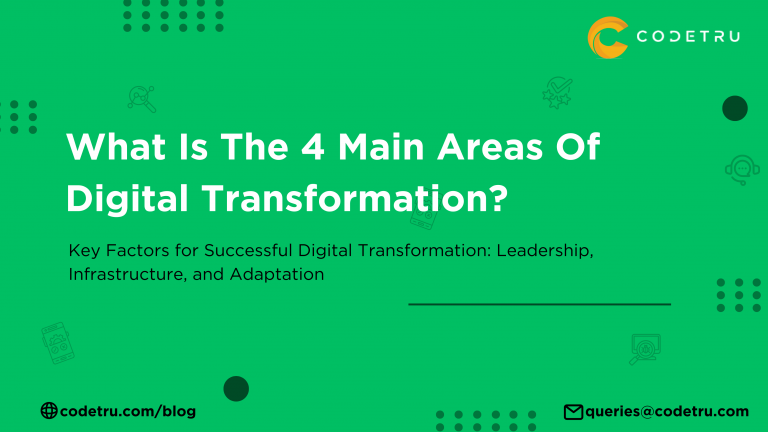What is Digital Transformation?
Digital transformation is the reimagining of business and all processes related to it in the digital age are digital transformation. At its heart, digital transformation is about a quantum leap in transforming processes that were manual or old tech to digital processes enabled by the latest advances in technology. To digitally transform, companies must go through the process of using digital technologies, to create new or modify existing business processes, culture, and customer experiences to stay relevant in the modern competitive landscape of similar service providers.
Digital transformation happens in 4 main areas, namely Business process, Business model, Domain, and Cultural/organizational. We often see corporations focused solely on the process or organizational transformation, as often it is possible to upgrade the hardware of machines, but the organization takes a lot of time to adapt and make efficient use of the new technology.
The key to digital transformation is understanding the potential of your technology intending to find practical solutions to everyday business needs. Transformation does not just mean speed, it includes all those elements that can be done better, giving the technology are challenges, as this shows what the technology is capable of, paving the way for businesses and processes to capitalize on technology investments.
One of the biggest areas of technology sector growth, Cloud-based services, and computing, is one of the many new industries spawned by digital transformation. Cloud computing has made itself indispensable for users by eliminating the need for users to own expensive hardware to run their computing needs. Instead, it has replaced it with a simple subscription model, where businesses can leverage the advanced computing bought to them by an expert in the field while having to pay a minimum subscription fee. Many global giants like Microsoft and Amazon make a fortune selling cloud computing services.
Digital solutions add to the capabilities of older, traditional software products like Microsoft Office and replace it with an online digital version called Office 365. However, other types of solutions are completely cloud-based, for example, Google Docs.
4 Main Areas of Digital Transformation
1. Business Process Transformation
Focuses on improving and automating processes through digital technologies to increase efficiency, reduce costs, and enhance productivity. This area involves rethinking how tasks are performed within the organization, using tools like AI, machine learning, and automation.
2. Business Model Transformation
Involves changing the way a company delivers value to its customers. This could mean adopting new revenue streams, shifting from product-based to service-based offerings, or leveraging digital platforms to create new business models.
3. Domain Transformation
Refers to the expansion into or creation of entirely new markets and industries by leveraging digital capabilities. This might involve entering adjacent sectors or innovating new products and services that disrupt traditional markets.
4. Cultural/Organizational Transformation
Focuses on changing the organizational mindset, culture, and structure to support continuous digital innovation. This area emphasizes fostering a digital-first culture, encouraging collaboration, and promoting agility within the organization.
The Subscription Model — All Are Winners
This subscription model in many ways had turned out to be the most sustainable long-term growth driver. This is because, for the service providers, or the software developers are guaranteed monthly income. This ensures good cash flow and provides the capital needed to keep developing new software or upgrade the existing applications. For standalone software of the yore, this reduces the risk of losing investments in further development, as historically these companies could earn revenue from users only when they bought or upgraded.
The new upgrades or new purchases are neither forecast-able nor monthly assured, so the developers’ invest was a risk as they had to invest upfront for developing new features and benefits to compel users to upgrade, and delivering more frequent updates often using forms of agile software development internally. Also, in the subscription model, the users are accessing software hosted on a cloud, which also reduces the chances of software piracy, bringing the maker of the app a major advantage, as all the consumers will pay.
If we see Netflix, Earlier movie renting meant going to the stores and combing through shelves until you found something to watch. Now, Digital libraries of Content are served on personal devices. There they take advantage of technology like predictive analytics to give users recommendations based on user preferences and viewing behavior, this has been a real boon to all video-based business models.
While embracing subscription-based content was an obvious disruption to the brick-and-mortar video rental business, it also leads companies like Netflix to innovate further with the available technology, leading to innovations like ‘content recommendation’ system driven by artificial intelligence.
Going Further Than Ever Before — More Efficacy
With revenue stream secured and in place, the app development can then go-ahead full steam, some of such benefits has been in increasing efficiency via automation. This also allows the developers to come up with new types of innovation and creativity over and above adding or upgrading the existing apps or software.
The introduction of the World Wide Web hugely expanded the scope, dimension, scale, speed as well as effects of digitalization fundamentally. This resulted in the increased pressure on the societal transformation process. To be accurate, it may not be stretch to say that Digital transformation is already underway, but there are differences in how countries, companies, policies, and businesses are in different stages of adoption
Adapting Businesses to Leverage Digital Transformation
Digital transformations have radically changed the business’ approach to customer service. In the old ecosystem, the business waited for consumers to come to find them, a difficult process to come to fruition thus limiting the growth potential of companies. But with the adoption of social media by masses has changed service just like it has impacted traditional advertising, marketing, media and even sales and customer service, models.
Companies that have embraced social media as a chance to extend their service offerings by meeting customers on their platforms of choice seen an explosion in business, so much so that there big global brands, which exist mainly due to digital transformation. From ride-hailing apps to hotel bookings, the services are offered are now endless.
In the 2000s, Call Centers and in-store service desks were the first to be run more efficiently with digital technology. But the real transformation came when the business started looking at all the available technologies to adopt their business faster and become more relevant to customers and thus providing them with a better experience. Businesses need to adapt their service offerings to take advantage of the reach and influence of social media. That would be the end goal of digital transformation, as far as consumer choice maximization is concerned.
But the transformation of just business is not enough, as it is an ecosystem, different systems are like different languages coming from different cultures, so it is vital that eventually, all major arms of government and business go digital
Transformations Are Hard, and Digital Ones Are Harder
One of the digital transformations was the vision of ‘going paperless’. A business was said to have reach ‘digital business maturity’ if it conducted its affairs digitally. However, it was noticed to affect not just businesses but whole segments of society, such as government, communications, art, medicine, and science to name a few.
Accelerated change
After the initial success of companies like Dell in the 1990s, who used digital methods to understand and predict their consumer needs, In early 2000s, digitalization began to gain popularity as a concept and argument leading to governmental adoption of IT infrastructures and increased usage of internet and IT on all levels, impacting masses of people.
The EU started the Digital Single Market, with recommendations for national digital agendas, which gradually and positively could contribute to the future societal transformation aiding in the faster development of communities. The IT structures create a basis for e-governance and information society.
But Years of research on transformations has shown that the success rate for these efforts is consistently low. In 2016, one of the world-leading management consultancies, McKinsey Global Institute carried out a study to and created an Industry Digitization Index, a measure of how far the digital transformation has adopted. As per the report, Europe was operating at 12% of its digital potential, whereas the United States is operating at 18%.
Even within Europe, Germany operates at 10% whereas the United Kingdom is almost on par with the United States at 17%. The study defined an “effective digital transformation program” as:
“The What”: the intensity of digital initiatives within a corporation.
“The How”: the ability of a company to master transformational change to deliver business results’
In July 2017, a survey of 1239 global IT and business professionals by the digital performance management company Dynatrace. Nearly half of the businesses “stated digital performance challenges were directly hindering the success of digital transformation strategies in their companies”, with nearly 75% of them “who had low levels of confidence in their ability to resolve digital performance problems”.
Impact
Thus, there are increased calls for complete digitalization for better practical applications in politics, business, and social issues, like linking political work issues for community development, more practical business approaches, effective opportunities for organizations in operational and business process development. The digital transformation is slated to generate over $370 billion in global value by 2020.
What is the Best Route?
Research points to a set of factors that might improve the chances of a transformation succeeding. These factors fall into five categories:
1. The digital-savvy leader who can see and work out to use technology
2. Then built the infrastructure and train the resources for it
3. Asking and empowering people to find a new way to work using the changes
4. Keeping people and teams abreast with the latest changes
5. Keeping the habit of communication constant as the culture changes
FAQs About Digital Transformation
1. What are the four main areas of digital transformation?
Digital transformation focuses on four main areas: Business Process, Business Model, Domain, and Cultural/Organizational. These areas ensure a comprehensive overhaul of a company’s operations, leading to improved efficiency, innovation, and customer experience.
2. How does digital transformation improve business processes?
Digital transformation improves business processes by leveraging digital technologies to automate manual tasks, streamline workflows, and enhance data analysis. This leads to increased productivity, reduced costs, and the ability to make data-driven decisions.
3. What are the benefits of adopting cloud computing in digital transformation?
Cloud computing offers numerous benefits in digital transformation, including cost savings, scalability, and flexibility. It enables businesses to access advanced computing resources without the need for expensive hardware, allowing for seamless integration and innovation.
4. How can businesses ensure successful digital transformation?
To ensure successful digital transformation, businesses should understand the potential of their technology, build the necessary infrastructure, and train their teams. It’s essential to foster a culture of continuous improvement and maintain open communication throughout the process.
5. What impact does digital transformation have on customer experience?
Digital transformation significantly enhances customer experience by utilizing technologies like predictive analytics and AI. It enables businesses to deliver personalized experiences, improve customer service, and respond quickly to market changes, leading to higher customer satisfaction and loyalty.




